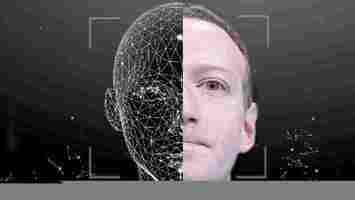Can deepfake detectors keep up with advances in AI-generated video?
An investigative journalist receives a video from an anonymous whistleblower. It shows a candidate for president admitting to illegal activity. But is this video real? If so, it would be huge news – the scoop of a lifetime – and could completely turn around the upcoming elections. But the journalist runs the video through a specialized tool, which tells her that the video isn’t what it seems. In fact, it’s a “ deepfake ,” a video made using artificial intelligence with deep learning .

Journalists all over the world could soon be using a tool like this. In a few years, a tool like this could even be used by everyone to root out fake content in their social media feeds.
As researchers who have been studying deepfake detection and developing a tool for journalists, we see a future for these tools. They won’t solve all our problems, though, and they will be just one part of the arsenal in the broader fight against disinformation.
The problem with deepfakes
Most people know that you can’t believe everything you see. Over the last couple of decades, savvy news consumers have gotten used to seeing images manipulated with photo-editing software. Videos, though, are another story. Hollywood directors can spend millions of dollars on special effects to make up a realistic scene. But using deepfakes, amateurs with a few thousand dollars of computer equipment and a few weeks to spend could make something almost as true to life.
Deepfakes make it possible to put people into movie scenes they were never in – think Tom Cruise playing Iron Man – which makes for entertaining videos. Unfortunately, it also makes it possible to create pornography without the consent of the people depicted. So far, those people, nearly all women, are the biggest victims when deepfake technology is misused.
Deepfakes can also be used to create videos of political leaders saying things they never said. The Belgian Socialist Party released a low-quality nondeepfake but still phony video of President Trump insulting Belgium , which got enough of a reaction to show the potential risks of higher-quality deepfakes.
Perhaps scariest of all , they can be used to create doubt about the content of real videos , by suggesting that they could be deepfakes.
Given these risks, it would be extremely valuable to be able to detect deepfakes and label them clearly. This would ensure that fake videos do not fool the public, and that real videos can be received as authentic.
Spotting fakes
Deepfake detection as a field of research was begun a little over three years ago . Early work focused on detecting visible problems in the videos, such as deepfakes that didn’t blink . With time, however, the fakes have gotten better at mimicking real videos and become harder to spot for both people and detection tools.
There are two major categories of deepfake detection research. The first involves looking at the behavior of people in the videos. Suppose you have a lot of video of someone famous, such as President Obama. Artificial intelligence can use this video to learn his patterns, from his hand gestures to his pauses in speech. It can then watch a deepfake of him and notice where it does not match those patterns. This approach has the advantage of possibly working even if the video quality itself is essentially perfect.
Other researchers, including our team , have been focused on differences that all deepfakes have compared to real videos. Deepfake videos are often created by merging individually generated frames to form videos. Taking that into account, our team’s methods extract the essential data from the faces in individual frames of a video and then track them through sets of concurrent frames. This allows us to detect inconsistencies in the flow of the information from one frame to another. We use a similar approach for our fake audio detection system as well.
These subtle details are hard for people to see, but show how deepfakes are not quite perfect yet . Detectors like these can work for any person, not just a few world leaders. In the end, it may be that both types of deepfake detectors will be needed.
Recent detection systems perform very well on videos specifically gathered for evaluating the tools. Unfortunately, even the best models do poorly on videos found online . Improving these tools to be more robust and useful is the key next step.
Who should use deepfake detectors?
Ideally, a deepfake verification tool should be available to everyone. However, this technology is in the early stages of development. Researchers need to improve the tools and protect them against hackers before releasing them broadly.
At the same time, though, the tools to make deepfakes are available to anybody who wants to fool the public. Sitting on the sidelines is not an option. For our team, the right balance was to work with journalists, because they are the first line of defense against the spread of misinformation.
Before publishing stories, journalists need to verify the information. They already have tried-and-true methods, like checking with sources and getting more than one person to verify key facts. So by putting the tool into their hands, we give them more information, and we know that they will not rely on the technology alone, given that it can make mistakes.
Can the detectors win the arms race?
It is encouraging to see teams from Facebook and Microsoft investing in technology to understand and detect deepfakes. This field needs more research to keep up with the speed of advances in deepfake technology.
Journalists and the social media platforms also need to figure out how best to warn people about deepfakes when they are detected. Research has shown that people remember the lie , but not the fact that it was a lie. Will the same be true for fake videos? Simply putting “Deepfake” in the title might not be enough to counter some kinds of disinformation.
Deepfakes are here to stay. Managing disinformation and protecting the public will be more challenging than ever as artificial intelligence gets more powerful. We are part of a growing research community that is taking on this threat, in which detection is just the first step.
This article is republished from The Conversation by John Sohrawardi , Doctoral Student in Computing and Informational Sciences, Rochester Institute of Technology and Matthew Wright , Professor of Computing Security, Rochester Institute of Technology under a Creative Commons license. Read the original article .
Facebook’s making a wearable that uses your nerve signals to control AR environments
Facebook is developing a new input device for AR glasses: a wristband that lets you interact with virtual reality by moving your fingers.

The system uses electromyography (EMG) to convert nerve signals passing through the wrist into digital commands.
Facebook says that these signals are so clear that EMG can understand finger motions of just a millimeter:
The devices also use contextualized AI to dynamically adapt to you and your environment.
Facebook still hasn’t revealed a release date for the wristbands, but unveiled two prototype devices in a Thursday blog post .
The company says it explored a range of other input sources before deciding the wrist has some unique benefits:
Initially, Facebook plans to use EMG for just one or two finger movements, which it refers to as “intelligent clicks.” But the company expects the signals to eventually fully control virtual objects and interfaces.
Greetings Humanoids! Did you know we have a newsletter all about AI? You can subscribe to it right here .
An end to constant cookie warnings? UK plans post-Brexit overhaul of data laws
Did you know Neural is taking the stage this fall ? Together with an amazing line-up of experts, we will explore the future of AI during TNW Conference 2021. Secure your online ticket now !

Brexit may be causing food shortages , export pains , and economic damage , but the UK could reap one big benefit from leaving the EU: an end to constant cookie warnings.
The country has unveiled plans to overhaul its privacy rules while maintaining an alignment with the EU’s General Data Protection Regulation (GDPR).
Digital Secretary Oliver Dowden told The Telegraph that the changes would get rid of “endless” cookie pop-ups, which websites use to comply with EU laws.
The EU says the banners help protect privacy rights, but the notifications feel pretty pointless when almost no one reads them.
Dowden said the plan is to only require banners on “high risk” sites:
The reforms will be overseen by a new head of the country’s data regulator. The government has named New Zealand’s privacy commissioner, John Edwards, as its preferred candidate for the role.
Killing cookie warnings
In a press release , Dowden said he was “determined” to develop a data policy that will “deliver a Brexit dividend” for people and businesses in the UK.
His plan to banish irksome cookie warnings is certainly attractive, but the new rules will need to be accepted by the EU. If they’re not, data transfers between the bloc and the UK could be thrown into chaos.
Brussels recently ruled that British data protection rules are “adequate.” But it added that the decision could be revoked “immediately” if the UK’s standards weaken.
Greetings Humanoids! Did you know we have a newsletter all about AI? You can subscribe to it right here .